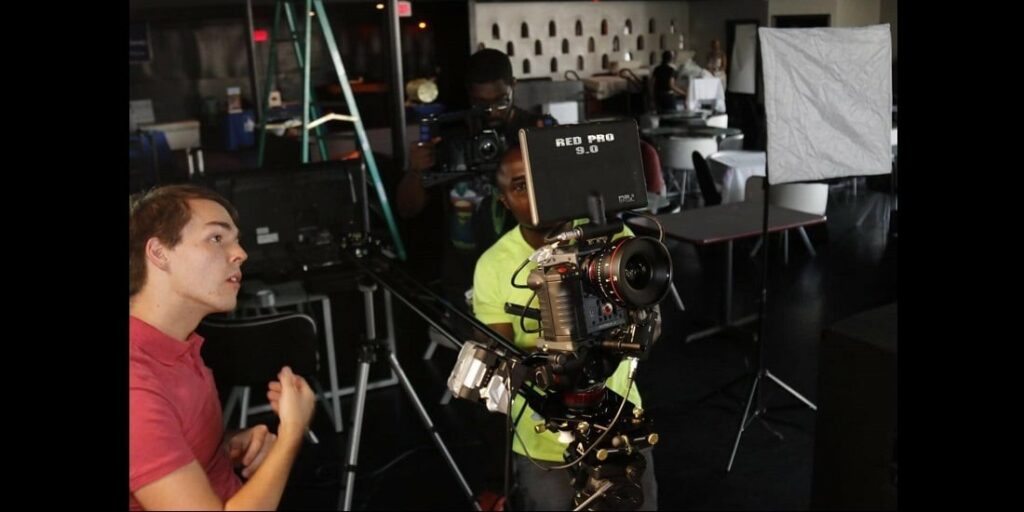What Does a Key Grip Do?
Key Grip Defined

The key grip is the head of the grip department and supervises all of the grips on a film shoot. If the film production is a feature film, the key grip usually has a second person to assist them in managing the grips, called the “best boy” or “best girl” who make sure the key grip’s requests are carried out.
As stated in an informative article in the New York Times about female key grips: “Grips build platforms, set up rigging and the equipment that shapes and diffuses lighting, mount cameras onto cars and cranes onto buildings, and schlep 35-pound sandbags known as ballbusters.”
The grip department, under the supervision of the key grip, provides all support systems for lights and cameras. Their two main responsibilities on film set are to provide support to the camera department through setting up the rigging and to set up lighting rigs for the lighting technicians. This is especially true if the camera is in an unusual position, or is mounted to a dolly, crane, or other devide. Although grips do not set the lights for filming they assist the electrical department in creating and executing lighting set-ups for shots under the direction of the director of photography or DP.
When it comes to the cameras, grips set up and man dollies, cranes, tripods, car mounts and other camera support devices. Anything that needs to be moved with a crane, hoisted, mounted or otherwise transported through the use of another device is in the domain of the grip department. Once the lights are set, the grip department cuts and shapes the lights as requested by the key grip and the gaffer.
The Key Grip Hires these Crew Members
In addition to these technical tasks, the key grip is also responsible for all grip equipment orders and grip crew hires. The key grip is involved in pre-production meetings with the director, producer, director of photography and location scouts during which any special equipment needs are discussed and agreed to.
When the film is in production, the key grip works with the gaffer and supervises the grips as they move and position scrims, reflectors, flags, gobos and other equipment that directs, diffuses or cuts light or creates shadows. They also oversee grips who handle camera movement involving dollies, cranes and other support systems. Once built, the set becomes the responsibility of the grip department which means the key grip is also directly responsible for on-set safety.
The key grip is mainly a supervisory position. The grunt work of physically moving equipment around is tasked to the grip crew. On feature films, grips do not actually touch the lights or the electrical power distribution system—these tasks are handled by the electrical department under the supervision of the gaffer.

Lighting related tasks that fall under the key grip and grip crew purview include setting up stands for flags, nets and other diffusing materials; creating passive fill “lighting” by reflecting light back onto a scene; erecting large, overhead diffusers to dim and soften sunlight on exterior shots; and setting up blackouts which block light from entering exterior facing doors and windows.
The Key Grip is a Specialized Job
While many grip positions are entry-level jobs, the key grip is not. It is a management position requiring extensive technical knowledge and experience. As a key grip you may no longer be involved in physically setting up equipment, but you still need to know how cranes, dollies, scaffolding, car mounts and other rigging equipment are set up and operated. The buck stops with the key grip when in comes to on-set safety so this knowledge is a necessity.
Qualities of a Good Key Grip
The key grip also needs to be good at thinking on their feet. The director and director of photography will often throw a last-minute curve ball at the key grip when it comes to camera angles and lighting effects. It’s the job of the key grip to execute these changes in the plan quickly and efficiently.
Finally, the key grip needs to have excellent communication skills. Between pre-production and production, they will work closely with the director, director of photography, gaffer and producer, most of whom have strong egos. The key grip must be able to communicate clearly with them without being intimidated. Additionally, the key grip needs to communicate with the grip crew, making sure they are hardworking, inspired, motivated and doing things safely and properly.
How Key Grips Get Started in Film
Most key grips work their way up the ladder by starting as a grip. Being a grip is something you really can’t learn from reading a text book, you need to learn it by doing it. One way to get such practical experience as a grip is to attend a film school that offers externships. These externships can expose you to multiple film production shoots over the course of your education. This allows you to observe first-hand what a grip does on a film set, and in many cases provide an opportunity to work as a grip on one of the productions. From there, it’s up to you to demonstrate the knowledge and ability to have what it takes to become a key grip.
